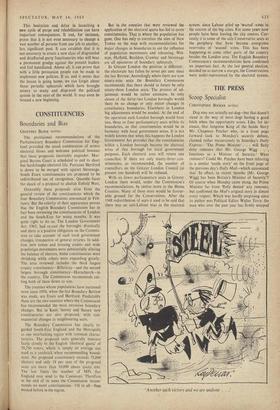GEOFFREY BLOCK writes: The provisional recommendations of the Parliamentary Boundary
Commission for Eng- land provided the usual combination of severe electoral blows and welcome political bonuses that these proposals inevitably engender. Mar- ginal Barons Court is scheduled to end its short but hard-fought electoral life. Patrician Hertford is down to be merged with upstart Stevenage. South Essex constituencies are proposed to be redistributed out of recognition. Quoodle faces the shock of a proposal to abolish Enfield West.
Ostensibly these proposals arise from the general review of the constituencies which the four Boundary Commissions announced in Feb- ruary.' But the celerity of their appearance proves that the English Boundary Commission has in fact been reviewing the constituencies of London and the South-East for many months. It was quite right to do so. The London Government Act, 1963, had re-cast the boroughs drastically and there is a positive obligation on the Commis- sion to take account of such local government changes, irrespective of general reviews. In addi- tion new towns and housing estates and wide population movements were substantially altering the balance of electors. Some constituencies were shrinking while others were expanding greatly. The area reviewed includes the third largest county constituency—Billericay—and the second largest borough constituency—Hornchurch—in the country. The Commission recommends cut- ting both of these down to size.
The counties whose populations have increased most since 1954, when the last Boundary Review was made, are Essex and Hertford. Predictably these are the two counties where the Commission has recommended the most extensive boundary changes. But in Kent, Surrey and Sussex new constituencies are also proposed, with con- sequential changes in neighbouring seats.
The Boundary Commission has clearly re- garded South-East England and the Metropolis as one interlocking region with common charac- teristics. The proposed seats generally measure fairly closely to the English 'electoral quota' of 58,750 voters, which is simply an average size used as a yardstick when recommending bound- aries. No proposed constituency exceeds 75,000 electors and only 18 per cent of the proposed seats are more than 10,000 above quota 'size. The law limits the number of MPs that. England may send to the Commons. Therefore at the end of its sums the Commission recom- mends no more constituencies-156 in all—than existed before in the region.
But is the counties that were reviewed the application of the electoral quota has led to more constituencies. That is where the population has gone. One has only to correlate the sites of New Towns on the map with recommendations for major changes in boundaries to see' the influence of population movements and rehousing. Wel- wyn, Hatfield, Basildon, Crawley and Stevenage are all epicentres of boundary upheavals.
In Greater London the position is different: the electorate has fallen by seven per cent since the last Review. Accordingly where there are'now ninety-nine seats the Boundary Commission recommends that there should in future be only ninety-three London seats. The process of ad- justment would be rather extensive. In only eleven of the thirty-two London boroughs would there be no change or only minor -changes in constituency boundaries. ElseWhere in London big adjustments would be needed. At the end of the operation each London borough would have two, three or four parliamentary seats within its boundaries, so that constituencies would be in harmony with local government areas. It is not widely known that when this happens the London Government Act provides that the constituencies within a London borough become the electoral areas of that borough for local government purposes. Each electoral area will return one councillor. If there are only ninety-three/ con- stituencies, as recommended, the number of councillors on the Greater London Council (at present one hundred) will be reduced.
With six fewer parliamentary seats in Greater London there would, under the Commission's recommendations, be twelve more in the Home Counties. Many of these seats would be favour- able ground for the Conservatives. After the 1948 redistribution of seats it used to be said that there was an anti-Labour bias in the electoral system, since Labour piled up 'wasted' votes in the centres of the big cities. For some years now people have been leaving the city centres. Cur- rently it is some of the safe Conservative seats at the periphery that have become overgrown reservoirs of 'wasted' votes. This has been happening in some other parts of the country besides the London area. The English Boundary Commission's recommendations have confirmed an important fact. At the last general election, decided bn so narrow a margin, the Conservatives were under-represented by the electoral system.


































 Previous page
Previous page